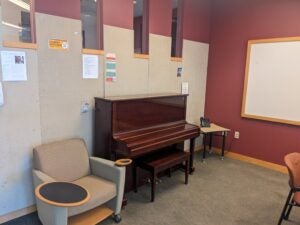By Myron F. Goodman, Professor of Biological Sciences and Chemistry
Upon my arrival at USC in 1973, as an Assistant Professor in the Department of Biological Sciences, I became part of a broadly eclectic cohort of colleagues. The wide diversity of research areas included bacteriology, marine biology, anthropology, ecology, biochemistry, physiology, aging, and protein chemistry. Largely absent from the mix was Molecular Biology.
The ‘80s and ‘90s ushered in a crucial shift in emphases. Roughly, ten new faculty were hired from Assistant to Full Professors that included the inventor of DNA footprinting, the development of parsimony concepts in evolution, transposable genetic elements, prokaryotic and eukaryotic DNA and RNA enzymology, Drosophila developmental genetics, and one of the distinguished inventors of PCR. Notably, there are only three of the original PCR machines in existence, one is housed at Cetus-Roche, a second at the Smithsonian Institution in Washington, and the third in Norm Arnheim’s office in RRI (home to MCB since 2004). The arrival of Martin D. Kamen, the co-discoverer of the radioactive isotope Carbon-14, was the catalyst for establishing Molecular Biology as a separate, independent section, within Biological Sciences. We could, at long last, hire and promote faculty solely from within our ranks, and establish and grow a superb graduate student program. Not incidentally, the ‘80s also bore witness to the birth of the field of Computational Biology. Michael Waterman (Smith-Waterman algorithm for DNA sequence alignment) and David Galas (DNA footprinting) melded the computational with the molecular resulting in the inception of MCB.
In 1973, the Biological Sciences faculty were distributed throughout parts of four locations, Allan Hancock Building, Science Hall (now called Zumberge Hall), and East and West Ahmanson buildings, the latter containing my new lab). A lucky happenstance followed by an unanticipated wake up call resulted in the establishment of MCB in a superb new building. Regarding the lucky happenstance, Alfred E. Mann, a noted biomedical entrepreneur donated funds to build a Biomedical Engineering Building. But the Biomedical Engineering Department was large in talent yet small in size. I suggested (with much more hope than conviction) that sharing of the proposed new building with Molecular & Computational Biology would be ideal for both Biomedical Engineering and for MCB. Naivety aside, this suggestion was acted on favorably by our farsighted collegial Biomedical Engineering faculty, with special credit to Professor David D’Argenio. After a period of perhaps three years, there followed two pivotal, indeed seismic, events that have brought us to where we are today – the superb RRI Building housing MCB with QCB (which “mitosed”-off as a separate department in 2022). Pivotal Event #1: Biomedical Engineering decided to accelerate the establishment of the Mann Institute, and moved into an already existing building on campus, leaving MCB a clear, albeit uncertain path to obtaining its own new building. The uncertainty in the path was that there was now no longer any financial underpinning. Since debt financing had never before been used to finance new building construction at USC, President Steven Sample put the building phase of the project on hold (the building had already been completely designed) until another financial angel could be found to fund the building. Pivotal Event #2: UC Berkeley decided to recruit Mike Waterman along with virtually our entire cohort of world class MCB computational colleagues; at which point President Sample rapidly approved construction of a new debt financed MCB building, which opened for business in 2005, and which contains a rather spectacular four-story high atrium (see picture). It was two years later that Dr. Ray R. Irani donated a generous naming gift, and so here we are in RRI (Ray R. Irani Hall).

In closing, a final noteworthy anecdotal event bears mentioning. RRI is home to a piano, an excellent upright spinet piano, located in the 2nd floor conference room (see picture), on which numerous MCB students exhibit their considerable musical talents. How a piano became a staple of RRI occurred as follows. The dedication and naming reception for the Ray R. Irani MCB building took place onFriday, February 9, 2007, in a huge tent just outside the about to be named MCB building, within which many Los Angeles luminaries “did lunch” with USC faculty. One of my students, Ronda Bransteitter, was selected to give a brief presentation of her research. Ronda, however, changed script – rather than drone on about research, she looked out at the audience and said,“a beautiful new building should come equipped with a new piano, as we count many talented performing musicians amongst us”, Ronda herself included. At which point President Sample took the podium and said, “who will bid to buy a piano”? Twenty or so well-healed guests immediately stood up to volunteer, with the winning bid going to USC’s revered Pat Haden, a celebrated Trojan and Los Angeles Rams (Super Bowl) quarterback, and past USC athletic director.
